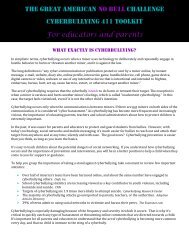The Great American NO BULL Challenge cyberbullying 411 toolkit ...
The Great American NO BULL Challenge cyberbullying 411 toolkit ...
The Great American NO BULL Challenge cyberbullying 411 toolkit ...
Create successful ePaper yourself
Turn your PDF publications into a flip-book with our unique Google optimized e-Paper software.
<strong>The</strong> fact that <strong>cyberbullying</strong> also takes place off-campus means that the behavior falls into a different legal and<br />
responsibility category for school administration. While behavior that takes place at school is clearly under<br />
the jurisdiction of administration, behavior that takes place off-campus usually falls under the parent<br />
responsibility category.<br />
Let’s be honest, because students are constantly connected 24/7, it can be difficult to define exactly when and<br />
where the <strong>cyberbullying</strong> is occurring. Most of the time, when a child is being cyberbullied, they’re being<br />
attacked at all hours of the day—not just while they’re at home, and not just while they’re at school.<br />
From a risk management standpoint, it’s recommended that these seven steps be taken (and well documented)<br />
regardless of the disruption to the school environment. Remaining silent is not a solution, and will only come back<br />
to haunt you if something goes terribly wrong after you have been made aware of the situation.<br />
Seven Important Steps for Educators, School Counselors and Administrators:<br />
1. Take all reports very seriously, even if the incident occurs off-campus. Have a discussion with the<br />
cyberbully, the target and with any bystanders who are involved in the digital warfare. Ideally, these<br />
discussions should take place with an administrator, preferably with the Principal. Take a complete written<br />
report of what happened and when. Obtain copies of the posts/texts if possible. If relevant, discuss future<br />
legal problems with the cyberbully if they continue their behavior. You should involve an SRO or other<br />
police officer, as well as the parents in the discussions whenever possible.<br />
2. Confront the cyberbully. Immediately discuss the consequences for bullying or <strong>cyberbullying</strong> in school<br />
with the bully. Follow through with consequences that are outlined within your school’s policies and<br />
procedures. If he/she engages in any bullying or <strong>cyberbullying</strong> during school or while on school campus,<br />
follow through on consequences immediately, document the process, and follow up accordingly based on<br />
your school’s policies and procedures.<br />
3. Organize a safety plan. This should include a trusted adult that students can go to if they need help. <strong>The</strong><br />
child’s teacher(s) must be told that this student has the freedom to go see their trusted adult at any time.<br />
Focus on the child’s sense of safety and ability to be present at school. It’s important to note that a<br />
restraining order might be necessary, depending on the degree of the situation. <strong>The</strong>re are excellent online<br />
tools that can help you manage this process which are included in the resource section of this <strong>toolkit</strong>.<br />
4. Communication should be your priority. It’s critical to put your student’s teachers, coaches, counselors,<br />
bus drivers, etc. on alert by communicating the situation that has occurred between the target and the<br />
bully. Instruct them to keep a very sharp eye open. Make sure to document all communication.<br />
5. Have a plan for less structured areas, such as buses, locker rooms, restrooms and the lunchroom. <strong>The</strong><br />
target should never be left to “hope” that they are safe. Do whatever you can do to map out a plan ahead of<br />
time, so the student feels safe no-matter where they are on campus. Remember, <strong>cyberbullying</strong> situations<br />
often play out in the physical sense.<br />
6. Follow up with the parents, especially the parents of the target. Do not wait for them to call you; call<br />
them to let them know what steps you are taking. Many parents want to know what disciplinary actions<br />
are being taken against a cyberbully and you may need to educate them about confidentiality laws. Be sure<br />
that they know you are not refusing to furnish information because you personally wish to protect a bully.<br />
Speak to them about the schools formal policies and procedures that are in place, and reassure them that<br />
you are taking every step very seriously, and that you’re going to make sure their child is safe while they<br />
are on your campus.<br />
7. Follow up with the target. Once a few weeks have passed since the original reporting of the incident, be<br />
sure to reach out to your student to confirm that all bullying has stopped. Ask them if they feel safe and<br />
secure while they are at school, and let them know that your door is always open should they ever need<br />
your help. Continue to keep an eye out for the safety and wellbeing of the student. Remember, even if the<br />
<strong>cyberbullying</strong> has stopped, the aftermath from being a target is long lasting and difficult to overcome.








